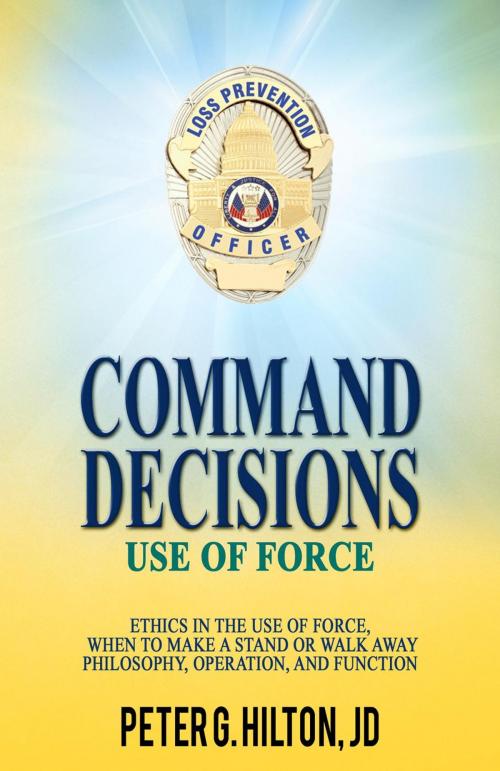Command Decisions: Use of Force
Nonfiction, Social & Cultural Studies, Political Science, Politics, Law Enforcement, International, International Security, Reference & Language, Education & Teaching, Educational Theory, Philosophy & Social Aspects| Author: | Peter Hilton | ISBN: | 9781524279400 |
| Publisher: | Peter Hilton | Publication: | January 13, 2016 |
| Imprint: | Language: | English |
| Author: | Peter Hilton |
| ISBN: | 9781524279400 |
| Publisher: | Peter Hilton |
| Publication: | January 13, 2016 |
| Imprint: | |
| Language: | English |
In 2015, there have been a total of one thousand one hundred and thirty four civilians shot to death by police (http://killedbypolice.net/) with a total of thirty six police officers in 2015 being shot and killed in the line of duty, there have been a total of one hundred and eighteen officers who died on duty during 2015 (https://www.odmp.org/search/year).
So far in 2015, U.S. police killed 776 people, 161 of whom were completely unarmed at the time of their death.
The data was compiled by The Guardian for a project called “The Counted,” a continuously updated, interactive database of police killings in the United States. Based on their figures, police have killed, on average, about three people per day so far this year. The Counted database is the most comprehensive information available on police killings, since no U.S. government agency maintains a similar listing.
Police killings in America have sparked a national movement for police reform, especially since the death of Mike Brown last year in Ferguson, Missouri.
Based on The Guardian’s statistics, police killed more white people than any other race this year. A total 385 white people have been killed by police this year, and 66 of them were unarmed at the time of their death.
However, activists like the members of the Black Lives Matter movement argue that police kill blacks at a rate disproportionate to their total percentage of the population — an assertion supported by The Guardian’s statistics. Police killed almost five black people per every million black residents of the U.S., compared with about 2 per million for both white and hispanic victims.
The vast majority of those killed — 745 — were men.
People were killed by police at all ages and in every state except Rhode Island, South Dakota and Vermont, three of the country’s least populated states. Certain cities stand out as more dangerous than others: The most police by killings occurred in Los Angeles (14 dead), Houston (11), Phoenix (9), New York (7) and Oklahoma City (7).
Shooting was the most common cause of police-related death, at 680. Of the 161 unarmed individuals, 71 were shot by police. The second most common cause of death found in the study were Tasers, which led to the deaths of 39 people, followed by being struck by police vehicles (26). Twenty-eight people died in police custody, according to The Guardian, but this figure does not include victims like Sandra Bland, who died in a Texas jail under conditions many describe as suspicious, although suicide was listed as her official cause of death.
Of the 582 people who were armed at the time of their death, 374 were carrying firearms and 107 were armed with knives. Of course, the numbers also cannot account for whether those killed were actively threatening police with their weapons versus those who were not, like Paul Castaway, the Native American man killed July 12 in Denver while holding a knife to his own neck.
Although police advocates claim the frequent use of force is necessary to protect officers from a highly dangerous job, the statistics don’t seem to back this up. The National Law Enforcement Officers Memorial Fund reported that 25 officers were killed by gunfire so far in 2015, with the Officer Down Memorial Pagenoting that two of those deaths came from accidental discharge of their firearms. (mintpressnews)
In 2015, there have been a total of one thousand one hundred and thirty four civilians shot to death by police (http://killedbypolice.net/) with a total of thirty six police officers in 2015 being shot and killed in the line of duty, there have been a total of one hundred and eighteen officers who died on duty during 2015 (https://www.odmp.org/search/year).
So far in 2015, U.S. police killed 776 people, 161 of whom were completely unarmed at the time of their death.
The data was compiled by The Guardian for a project called “The Counted,” a continuously updated, interactive database of police killings in the United States. Based on their figures, police have killed, on average, about three people per day so far this year. The Counted database is the most comprehensive information available on police killings, since no U.S. government agency maintains a similar listing.
Police killings in America have sparked a national movement for police reform, especially since the death of Mike Brown last year in Ferguson, Missouri.
Based on The Guardian’s statistics, police killed more white people than any other race this year. A total 385 white people have been killed by police this year, and 66 of them were unarmed at the time of their death.
However, activists like the members of the Black Lives Matter movement argue that police kill blacks at a rate disproportionate to their total percentage of the population — an assertion supported by The Guardian’s statistics. Police killed almost five black people per every million black residents of the U.S., compared with about 2 per million for both white and hispanic victims.
The vast majority of those killed — 745 — were men.
People were killed by police at all ages and in every state except Rhode Island, South Dakota and Vermont, three of the country’s least populated states. Certain cities stand out as more dangerous than others: The most police by killings occurred in Los Angeles (14 dead), Houston (11), Phoenix (9), New York (7) and Oklahoma City (7).
Shooting was the most common cause of police-related death, at 680. Of the 161 unarmed individuals, 71 were shot by police. The second most common cause of death found in the study were Tasers, which led to the deaths of 39 people, followed by being struck by police vehicles (26). Twenty-eight people died in police custody, according to The Guardian, but this figure does not include victims like Sandra Bland, who died in a Texas jail under conditions many describe as suspicious, although suicide was listed as her official cause of death.
Of the 582 people who were armed at the time of their death, 374 were carrying firearms and 107 were armed with knives. Of course, the numbers also cannot account for whether those killed were actively threatening police with their weapons versus those who were not, like Paul Castaway, the Native American man killed July 12 in Denver while holding a knife to his own neck.
Although police advocates claim the frequent use of force is necessary to protect officers from a highly dangerous job, the statistics don’t seem to back this up. The National Law Enforcement Officers Memorial Fund reported that 25 officers were killed by gunfire so far in 2015, with the Officer Down Memorial Pagenoting that two of those deaths came from accidental discharge of their firearms. (mintpressnews)















